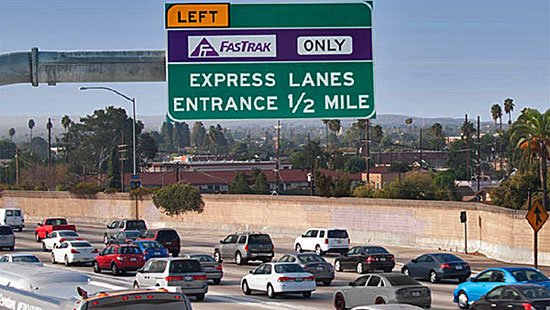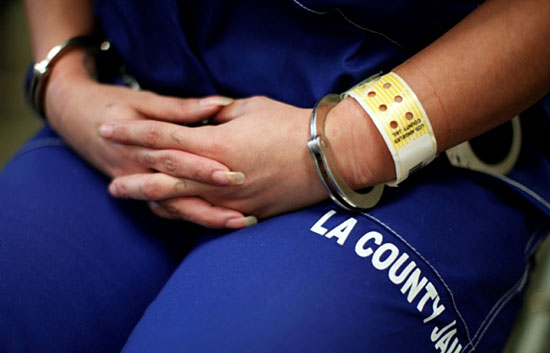Toll roads on a roll, minus fee
With drivers flocking to the ExpressLanes pilot project and revenue from the toll roads exceeding projections, Metro’s Board of Directors voted to continue to waive a controversial maintenance fee for L.A. County drivers who use the lanes only occasionally.
The board’s unanimous vote means that the $3 monthly maintenance fee will continue to be dropped for infrequent users at least until the pilot program wraps up early next year. The waiver had been set to expire on Friday, Oct. 25.
The toll roads pilot project, funded by a $210 million grant from the United States Department of Transportation, is set to conclude on Feb. 23, 2014, but if successful could be made permanent.
At the Metro board meeting Thursday, a motion to permanently drop the maintenance fee levied on occasional users was sent back to committee. Supervisor Zev Yaroslavsky, a board member who supports dropping the occasional user fee as a matter of fairness, argued in favor of moving proactively to make the waiver permanent. Given the overall boost in toll road revenue and the increase in drivers signing up for the transponders needed to take part in the program, revenue lost by waiving the maintenance fee is minimal, he said.
“Revenues generally on the ExpressLanes are far in excess of what anybody had anticipated,” Yaroslavsky said. “What we’re finding now, I believe, is that more people are signing up for [ExpressLanes] transponders because they haven’t been required to pay this fee.”
However, Supervisor Mark Ridley-Thomas said it was too soon to tinker with the program, and Supervisor Gloria Molina said there shouldn’t be a “rush to judgment” on dropping the fee before there’s a fuller study of how that might affect revenue available to reinvest in transit improvements in communities along the ExpressLanes corridors. “I don’t think we should make it permanent,” she said.
Stephanie Wiggins, who is heading up the pilot project for Metro, said that dropping the maintenance fee would cost the agency $1.5 million a year. But, she said, that is offset by the overall spike in revenue: By the end of last month, the ExpressLanes already had generated more than $20 million in gross revenues, well ahead of the $18 million to $20 million anticipated by the project’s conclusion.
According to Metro forecasts, between $16 million and $19 million of that would be available for reinvestment for transportation improvements within the corridors, Wiggins said.
In addition to the unforeseen revenue, far more people are using the program than the 100,000 originally anticipated. As of last month, 176,243 were participating, with 85,102 of those deemed occasional users because they make three or fewer trips a month on the ExpressLanes.
The first ExpressLanes opened on an 11-mile stretch of the 110 Freeway last November. A second stretch on the 10 Freeway from Alameda Street in downtown Los Angeles to the 605 Freeway opened in February.
All ExpressLanes motorists—including carpoolers—are required to obtain a FasTrak transponder and to create an account from which tolls are deducted. Except for carpoolers, all users of the system pay to drive on the ExpressLanes, with amounts varying according to distance traveled and time of day. But, to the chagrin of many, only the occasional users were targeted with the monthly maintenance fee.
The board’s decision in April to temporarily lift the $3 fee had a beneficial effect, Wiggins said.
“Throughout the county, residents are benefiting from the five-month waiver,” she said, noting that the impact has been greatest among users in the South Bay, where the number of FasTrak accounts is highest.
Marianne Kim, representing the Automobile Club of Southern California, told Metro’s board that complaints to AAA about the program have gone down since the waiver went into effect.
Beyond the positive data on revenue and driver participation in the program, there also was some generally upbeat news on travel speeds in the two ExpressLane zones.
Average travel speeds on the northbound 110 improved year-over-year in both the ExpressLanes and the general purpose non-paying lanes next to them during morning rush hour, according to measurements made by Caltrans in May and June. During the afternoon rush hour, the southbound ExpressLanes also were moving faster than they did before the project, but the general lanes were moving more slowly—30.3 mph, compared to 34.7 mph during the same period in 2012.
On the westbound 10, morning rush hour speeds improved in both the toll and general purpose lanes. However, speeds in both kinds of eastbound lanes were down during the afternoon rush hour; traffic was said to be “significantly impacted” by a Caltrans construction project in the area.
Posted 10/24/13








